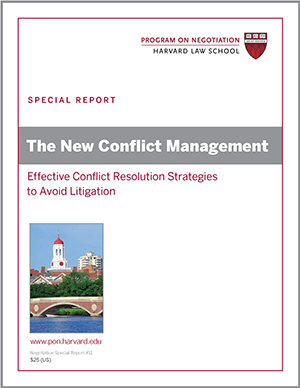
In the heat of conflict, it can be difficult to think rationally about how you got where you are and how you might make things better. But by taking a break to consider the elements of conflict, you can move toward a more rational assessment of the dispute and come up with ways to address it.
3 Elements of Conflict
Although there are many elements of conflict, the following three are among the most notable:
1. Interests.
Conflicts often arise when we fail to carefully think through our own interests. For example, you may take offense after hearing through the grapevine that a coworker took full credit for a project you completed together. You certainly have a short-term interest in correcting that false impression, if it’s true. At the same time, you may be overlooking a greater long-term interest: contributing to a functional workplace where conflicts are handled productively and relationships grow stronger. When you bring such long-term interests to the forefront, you become more capable of looking into the rumor carefully rather than immediately confronting your coworker.
When conflicts escalate, a new interest can emerge: the desire to punish or otherwise harm the other party for perceived wrongdoing, write Gabriella Blum and Robert H. Mnookin in The Negotiator’s Fieldbook (ABA, 2006). This interest in exacting revenge often arises when we assume the worst about the other party and their contribution to the conflict.
More specifically, due to the fundamental attribution error, a pervasive human tendency, when things go wrong in our lives, we often blame factors outside of our control; but when things go wrong for others, we tend to blame fundamental aspects of their character. For example, if your roof leaks a year after it’s been replaced, you may accuse the roofing company of doing a bad job, while the roofing company may blame you for not cleaning your gutters. The truth may lie in a gray area in between.
When managing conflict in organizations and beyond, acknowledging our own potential contribution to conflict can help us focus on our long-term interests and negotiate solutions.
2. Alternatives.
Our alternatives are another one of the primary elements of conflict. Experienced negotiators understand the importance of identifying their best alternative to a negotiated agreement, or BATNA before talks get underway. When we have a strong sense of our BATNA, we will position ourselves to accept no less than we can get elsewhere and increase our bargaining power.
Parties in conflict also need to consider their BATNA—that is, what they will do if they fail to resolve the dispute. Depending on the situation, this may mean ending a relationship, making a formal complaint, or even filing a lawsuit.
Unfortunately, we tend to be overly optimistic about our odds of prevailing in litigation, arbitration, and other high-risk methods of conflict resolution. Researchers have found that we tend to overestimate the likelihood that a judge or other arbiter will rule in our favor, note Blum and Mnookin.
To avoid this trap, we (and our lawyers) need to spend at least as much time thinking about the evidence and opinions that the other side would present as we spend thinking about the merits of our own case. When we do, we can arrive at a more rational assessment of what happened—and become more willing to negotiate an end to the conflict.
3. Identity.
Conflicts often tap into our deepest sense of our own identity. To take a couple of examples of conflict situations, if your boss accuses you of doing a poor job on an assignment, you may feel as if your identity as a skilled, hard-working employee is under attack. And if you lose your temper when scolding your child for making a mess just after you’ve cleaned the house, you may question your identity as a reasonable, empathic parent.
Because they lead us to question our essential competence and goodness, such “identity quakes” can knock us off-balance and worsen conflict, write Douglas Stone, Bruce Patton, and Sheila Heen in their book Difficult Conversations: How to Discuss What Matters Most. When the other party feels similarly attacked, we may conclude the relationship is beyond repair.
According to Stone, Patton, and Heen, an important step in conflict management is to explore and acknowledge our identity issues. We need to think through our own vulnerabilities—some of which may date back to childhood—and how they may be resonating in the present. If you often felt overlooked as a child, you may be quick to believe that others are excluding or ignoring you.
Remember that such conclusions can be an oversimplification or misreading of the problem. By considering our contributions and forgiving ourselves for our missteps, we can become more capable of listening to the other party’s perspective—an important step in resolving conflict.
What other elements of conflict have you observed in your own disputes, and how have you addressed them?





Comments are closed.